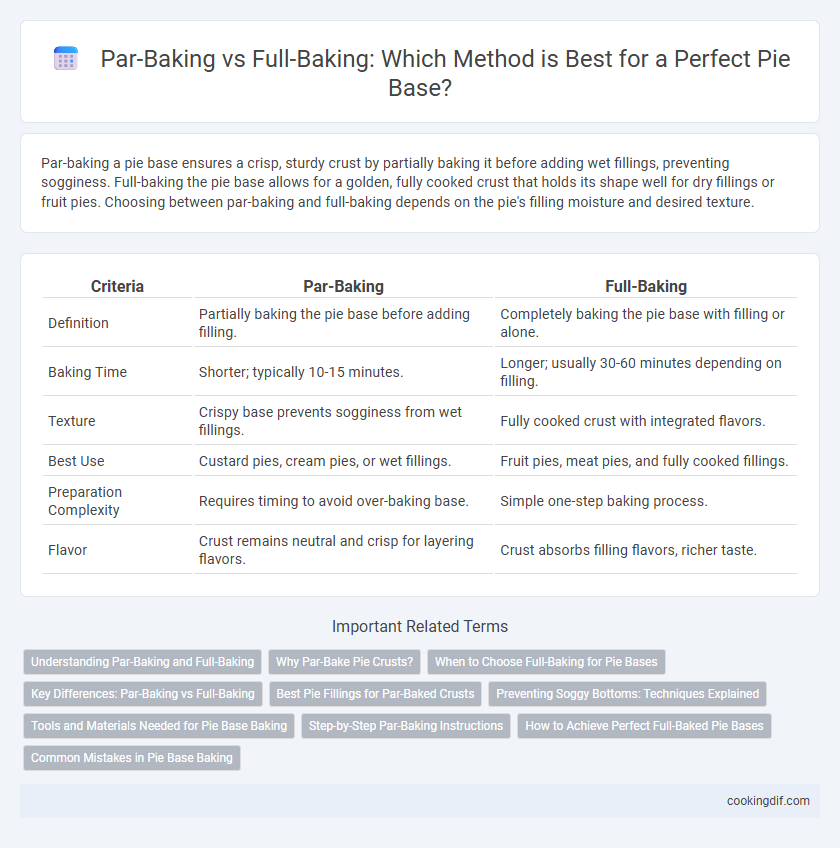Par-baking a pie base ensures a crisp, sturdy crust by partially baking it before adding wet fillings, preventing sogginess. Full-baking the pie base allows for a golden, fully cooked crust that holds its shape well for dry fillings or fruit pies. Choosing between par-baking and full-baking depends on the pie's filling moisture and desired texture.
Table of Comparison
| Criteria | Par-Baking | Full-Baking |
|---|---|---|
| Definition | Partially baking the pie base before adding filling. | Completely baking the pie base with filling or alone. |
| Baking Time | Shorter; typically 10-15 minutes. | Longer; usually 30-60 minutes depending on filling. |
| Texture | Crispy base prevents sogginess from wet fillings. | Fully cooked crust with integrated flavors. |
| Best Use | Custard pies, cream pies, or wet fillings. | Fruit pies, meat pies, and fully cooked fillings. |
| Preparation Complexity | Requires timing to avoid over-baking base. | Simple one-step baking process. |
| Flavor | Crust remains neutral and crisp for layering flavors. | Crust absorbs filling flavors, richer taste. |
Understanding Par-Baking and Full-Baking
Par-baking involves partially baking a pie crust to set its structure before adding fillings, preventing sogginess and ensuring a crisp base, commonly used for fruit or custard pies. Full-baking means baking the pie crust completely on its own or with filling, creating a fully cooked, golden-brown crust that supports heavier ingredients like savory or deep-dish pies. Understanding the differences between par-baking and full-baking helps achieve the desired texture and prevents undercooked or soggy pie bases in various recipes.
Why Par-Bake Pie Crusts?
Par-baking pie crusts partially cooks the dough, preventing a soggy bottom by forming a crisp barrier before adding the filling. This technique is essential for custard or cream pies with wet fillings that require minimal baking time. Par-baking ensures a flaky, golden crust, enhancing texture and structural integrity in the final pie.
When to Choose Full-Baking for Pie Bases
Full-baking a pie base is essential when using wet fillings like custards or fruit mixtures to prevent soggy crusts and ensure structural integrity. This method creates a firm, golden-brown shell that holds its shape and resists moisture infiltration during baking. Select full-baking for pies requiring a crisp, fully cooked base to enhance texture and flavor consistency throughout.
Key Differences: Par-Baking vs Full-Baking
Par-baking a pie base involves partially baking the crust before adding the filling, which helps prevent sogginess and maintains a crisp texture. Full-baking cooks the entire pie with both crust and filling simultaneously, ensuring the flavors meld but potentially resulting in a softer crust. Choosing between par-baking and full-baking depends on the pie type and desired crust texture, with par-baking favored for wet fillings and full-baking preferred for custard or cream pies.
Best Pie Fillings for Par-Baked Crusts
Par-baking a pie crust ensures a crisp, sturdy base ideal for custard or cream-filled pies like chocolate, lemon meringue, and pumpkin, which require minimal additional baking. Fully baking can result in a soggy bottom when using wet fillings, while par-baked crusts maintain texture and prevent moisture absorption. Fruit pies such as apple or cherry benefit from full baking to meld flavors and soften fruit, whereas par-baked crusts excel with fillings that set quickly or are added after baking.
Preventing Soggy Bottoms: Techniques Explained
Par-baking the pie base involves partially baking the crust before adding the filling, which effectively prevents soggy bottoms by creating a firm, moisture-resistant barrier. Full-baking the crust fully cooks the base upfront, ensuring a crisp texture, but risks overbrowning if not carefully monitored. Utilizing techniques like docking, blind-baking with pie weights, and applying egg wash can further enhance crust crispness and moisture control.
Tools and Materials Needed for Pie Base Baking
Par-baking a pie base requires tools such as pie weights or dried beans to prevent crust puffing, along with parchment paper to line the shell. For full-baking, essential materials include a well-greased pie dish and an oven thermometer to maintain precise baking temperatures. Both methods benefit from a sharp, non-stick rolling pin and high-quality all-purpose flour for optimal crust texture.
Step-by-Step Par-Baking Instructions
For par-baking a pie base, preheat the oven to 375degF (190degC) and line the crust with parchment paper, then fill it with pie weights or dried beans to prevent shrinking. Bake the crust for 15 minutes until the edges begin to set, remove the weights and parchment, and bake for an additional 5-7 minutes until the base turns golden. This technique ensures a crisp, fully cooked bottom layer without overbaking the filling later.
How to Achieve Perfect Full-Baked Pie Bases
To achieve perfect full-baked pie bases, ensure the dough is evenly rolled to about 1/8 inch thickness and chilled thoroughly before baking to prevent shrinking and sogginess. Use pie weights or dried beans to blind bake the crust initially, then remove the weights halfway to allow the base to crisp fully without burning. Baking at a consistent 375degF (190degC) for 20-25 minutes ensures a golden, flaky crust ideal for both sweet and savory fillings.
Common Mistakes in Pie Base Baking
Common mistakes in pie base baking include underbaking the crust during par-baking, which can result in a soggy bottom when the filling is added, and overbaking during full-baking, causing an overly dry or burnt crust. Incorrect oven temperature is a frequent issue, as too low heat prevents proper setting of the base, while too high heat leads to uneven cooking. Using pie weights incorrectly or not lining the crust can also cause bubbles and shrinkage, affecting the texture and appearance of the pie base.
Par-baking vs Full-baking for pie base Infographic

 cookingdif.com
cookingdif.com